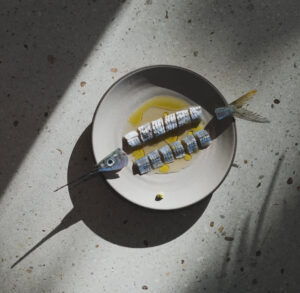Regardless of your family’s distinctive holiday traditions, it’s likely that the proceedings revolve in some way around the kitchen. The room has a certain magnetism—everyone seems to be drawn there. That’s why CULTURED asked four of our favorite chefs and recipe developers to take us inside their kitchens—professional or personal—to share a recipe that exemplifies where they are in their lives right now, along with their favorite ingredients and dining destinations from 2023. Check out this special holiday season edition of 5 Points of Culture below.
Chef and entrepreneur Rōze Traore is known for crafting distinctive dining experiences, most recently available in the boutique Cote d'Ivoire hotel, La Fourchette de Rōze, that he opened this year. There, the Eleven Madison Park and NoMad Hotel alum has launched a residency for artists from across the globe. In 2024, painter Marcus Leslie Singleton and the program's first musicians—Kilo Kish, Cktrl, and Kitty Cash—will kick off the year. Here, the chef shares his guide to preparing a seared Chilean sea bass with celery root puree and golden mushrooms.
3 ounces Sea bass
2 Sprigs thyme
1 Sprig rosemary
2 Cloves garlic
1 Lemon
1 Lemongrass
Bunch beech mushrooms
1 Celery root
1 White onion
1 Yukon potato
1 Horseradish
1 Quart milk
1 Stick of butter
Salt
Chives
Parsley
Grapeseed oil
1 Bayleaf
¼ Cup white wine
Puree:
Trim and clean celery root, then cut into ½-inch slices.
Peel and julienne onions.
Peel potatoes and cut them into one-inch slices.
To start, turn your heat to low to medium and drizzle enough oil to coat the pan.
Add the julienned onions, then season with a sprinkle of salt and let them sweat for about three minutes. Avoid color on your vegetables.
Add wine and let the alcohol cook out for two minutes
Proceed by adding the potatoes and celery root in the pot along with your milk.
Season with salt, add Lemongrass, bayleaf, and a sprig of thyme.
Let this cook on low to medium heat for 25 to 30 minutes until your ingredients are tender and translucent.
Once done, spoon out the onion, celery root, and potatoes then add to a blender.
Pour about ¼ of a cup of the reserved liquid into the blender and turn it on high (avoid the lemongrass and thyme).
While the blender is on, add one teaspoon butter and blend until all your ingredients are incorporated and smooth. Season to taste.
Place it on the side to keep warm.
Mushrooms:
Spilt your mushrooms into individual pieces.
Chiffonade parsley and chives.
Preheat pan to medium heat.
Drizzle enough oil to coat the bottom of the pan, then add mushrooms and season with salt and cracked pepper.
Cook for about five minutes or until golden brown.
Turn your heat off and zest and squeeze a wedge of lemon followed by chiffonade chives and parsley.
Place to the side to keep warm.
Fish:
Season fish with salt on both sides.
Preheat your pan on low heat.
Drizzle enough canola oil to coat the bottom of the pan.
Place fish in the pan skin side down.
Let fish cook for about four to five minutes or until the skin is golden.
Once crispy, turn the fish flesh side down and add one tablespoon of butter, thyme, rosemary, and smashed garlic.
Once butter is melted and partially foamy, turn the heat off.
Baste it on top of the fish for two minutes.
Remove from pan and begin with plating.
Chef and model Pierce Abernathy, co-founder of the food sustainability collective Aerthship, is on a mission to make eco-friendly food experiences aspirational. Juggling pop-up tours, modeling, and a commitment to sustainability in the kitchen, Abernathy brings a fresh approach to the fusion of food and art. Here, he shares a recipe-in-development for gigante beans with cider glazed squash and dandelion green gremolata.
This is a loose breakdown of a recipe I am continuing to work through. The recipe shared below is based off of a continued evolution from what I made in the video. The dish felt like it needed something to bring the squash and dandelion greens together. I chose some simple brothy beans. The beans make the dish hearty while not distracting from the flavors of the other two components.
Gigante Beans:
1 Pound gigante beans
Olive oil
Salt
3-4 Garlic cloves
1 Large yellow onion
Cider Glazed Squash:
2 Pounds winter squash
1/2 Gallon apple cider
1 Tablespoon apple cider vinegar
1 Tablespoon butter
Olive oil
Salt
Dandelion Green Gremolata:
1 Large white onion, thinly sliced
1 Bunch dandelion greens, finely chopped
3 Cloves garlic, thinly sliced
Olive oil
Salt
2 Teaspoons Sherry vinegar
1 Lemon
Soak dried beans overnight. Drain and add to a pot with fresh water, an aggressive amount of olive oil and salt, some garlic cloves, and a quartered onion. Bring to a boil then reduce to a simmer. Strain off any scum and cook until tender. Remove from heat and set aside.
Add three cups of apple cider to a pot and bring to a boil. Cook down until cider becomes syrupy and reduced substantially. Add in a splash of apple cider vinegar and one tablespoon of butter. Set aside.
Preheat your oven to 425F.
Rough chop squash into one-inch to two-inch pieces and transfer to a parchment-lined baking sheet. Season with salt and olive oil and roast for 20 minutes or until just tender. Remove from the oven and brush on cider glaze. Transfer back to the oven and cook for an additional five to eight minutes or until squash begins to caramelize and brown. Remove from heat and set aside.
Thinly slice one large onion and add to a pot with olive oil. Cook on medium, stirring often, until caramelized. About 20 to 30 minutes. Set aside.
Finely chop and rinse dandelion greens. Heat a large pan with a generous amount of olive oil and sauté greens until wilted. Add in two to three cloves of thinly sliced garlic and continue to cook until the garlic is fragrant and soft. Season with salt and remove from heat. Add in the caramelized onions, a splash of sherry vinegar, and lemon zest. Set aside.
To plate, add a handful of squash to a shallow bowl. Top with beans, a bit of the seasoned bean broth, and some spoonfuls of the dandelion gremolata. Garnish with sea salt, olive oil, and dried chile flakes.
The New York Times staff writer, essayist, and acclaimed recipe developer Eric Kim is a calming presence on the NYT Cooking YouTube channel, where he shares his expertise with a steady hand and a passion for creating comforting dishes like fluffy milk bread and gochujang buttered noodles. The best-selling author is also known for his debut cookbook, Korean American: Food That Tastes Like Home, which reflects on his upbringing in Atlanta, his heritage, and the essential facets of Korean cooking. Find Eric Kim’s New York Times Orzotto Alla Carbonara recipe here, and read his thoughts on the dish below.
If you've ever tried to make spaghetti carbonara at home, then you know how easily the eggs can scramble. It's not the end of the world, but I think what makes restaurant carbonara so irresistible is that perfect emulsion of egg, cheese, and pork fat.
I like this recipe because it gets you to that quintessential velvety texture and rich flavor in a more idiot-proof way, not least because the orzo is cooked in a little broth first (as in a risotto, but with less stirring). This ultimately gives you some extra starch in the final dish, which, once combined with the eggs, serves as insurance and helps keep their proteins from seizing. (Cornstarch does something similar to eggs; it "impedes the linking of proteins," my colleague Kenji Lopez-Alt writes.)
Another thing this recipe does: It teaches you the basic concept of tempering eggs—which just means bringing their temperature up gradually so they don't scramble when added to the hot pasta. The goal with carbonara is to somehow combine cold eggs and hot pasta without scrambling the former. Stirring a tiny bit of warm orzo into the eggs before adding that to the rest of the pasta ensures creaminess in the end, and requires zero finesse from the cook.
I love this recipe because you only dirty one pot, and it sort of fulfills that creamy, cheesy moment at the holidays. And as far as cooking goes, the motions are all very seamless. You can be slow or fast, precise or clumsy—you'll end up with a really beautiful carbonara thing in the end. This might not be an authentic spaghetti carbonara, but I think it teaches you the basic building blocks of what makes that original dish feel and taste so good and comforting.
Everyone says carbonara is bacon and eggs for dinner, but that completely ignores the cheese and the fact that a true carbonara (whether the dish or the flavor that's based on the dish, what I'm calling "alla carbonara") relies on guanciale and black pepper to complete its identity. I love a Christmas ham, but we still need to feed ourselves outside of the festal meals! And you can whip this one up in 30 minutes.
Andy Baraghani, a seasoned chef and food writer, began his culinary journey at restaurants Chez Panisse in Berkeley, California, and Estela in New York. After a notable career as a senior food editor at Bon Appétit, he set off to write his James Beard Award-winning cookbook, The Cook You Want to Be, and continues to bring people together through his love for vibrant and surprising recipes inspired by his Iranian heritage. Here, he shares his riff on a traditional sour cream and onion dip, an easy hit for the holidays.
1 Lemon
3 Cups full-fat Greek yogurt
1/3 Cup finely chopped dill
Kosher salt; freshly ground black pepper
2 Large shallots, thinly sliced into rings
1/2 Cup extra virgin olive oil
2 Teaspoons mild chile flakes, such as Aleppo
1 Teaspoon ground turmeric
Good crackers and crunchy vegetables, such as sliced cucumbers, carrots, endive leaves, broccolini
Mix the yogurt, lemon juice, zest, and dill in a medium bowl. Season with salt and lots of pepper. Give it a taste—it should be creamy, tangy, and salty.
Put the shallots in a small skillet and pour the oil over. (It’s okay if the shallots aren’t fully covered, they’ll shrivel up as they cook.)
Place the skillet over medium to high heat and cook, stirring occasionally until the shallots become crisp and golden brown, four to six minutes.
Remove the skillet from the heat and scoop out about half the crispy shallots from the pan, leaving as much oil in the pan behind, and mix into the bowl with the yogurt.
Sprinkle in the Aleppo pepper and the turmeric in the skillet with the remaining shallots and warm oil. Stir to bloom the spices and so that the oil will immediately be stained a beautiful, deep yellow.
Transfer the dip to a serving bowl and top with the spice shallot oil. Arrange whatever crunchy vegetables and crackers you like and serve.










 in your life?
in your life?

